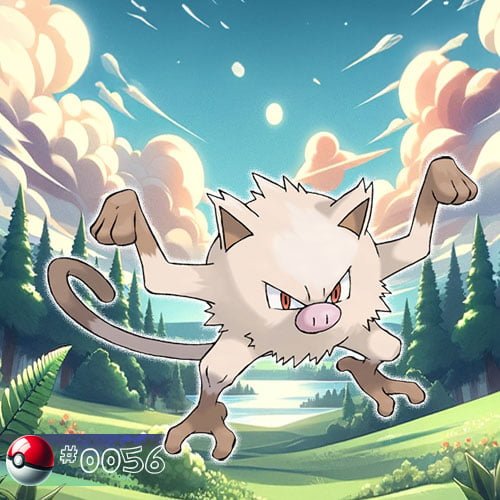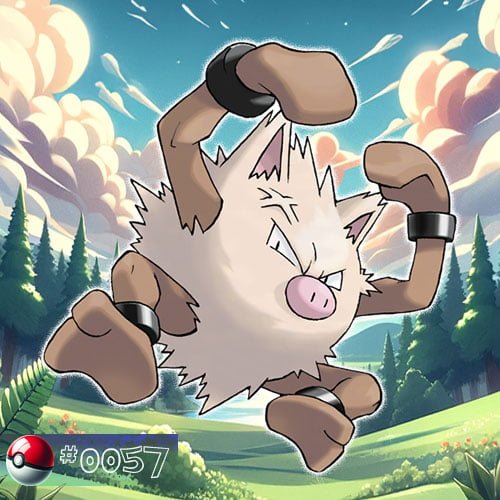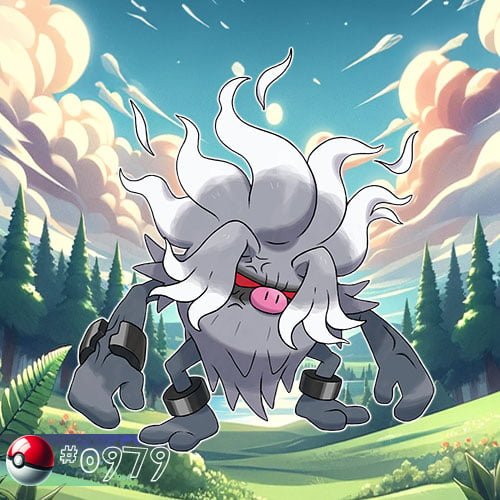Mankey
Mankey is a Fighting-type Pokémon known for its energetic and aggressive nature. With its short temper, Mankey is quick to anger, and it becomes even more ferocious as a Primeape, the evolved form).

| National Pokedex No: 0056 |
| Type: |
| Category: Pig Monkey Pokémon |
| Height: 0.5 m (1′08″) |
| Weight : 28.0 kg (61.7 lbs) |
| Gender: 50% ♂, 50% ♀ |
| Abilities/Hidden abilities: Vital Spirit or Anger Point/Defiant |
Biology
Physical Characteristics
Mankey is a Pokémon species that originates from the Pokémon franchise, known for its appearance and characteristics. Here are details about Mankey’s physical characteristics.
Mankey is known as the “Pig Monkey Pokémon.” Mankey has a distinct monkey-like appearance with a pig-like snout. It stands on two legs and has a furry, brown body with a cream-colored face, hands, and feet. Its small, round ears and large, expressive eyes give it a lively and energetic appearance.
Mankey is a small Pokémon, standing at around 1 meter (3 feet 3 inches) tall on average. It weighs approximately 28 kilograms (62 pounds). Mankey has a prehensile tail, which it uses for balance and to grasp objects. Its hands and feet have three fingers and toes, each tipped with claws, showcasing its Fighting type characteristics.
It has the pig-like snout on its face and its mouth is often seen in a perpetual grin. Mankey’s eyes are wide and filled with energy, contributing to its overall spirited appearance. Mankey is known for its short temper and can become enraged easily.
These physical characteristics contribute to Mankey’s unique and recognizable design within the Pokémon world. Its combination of Fighting and Normal types, along with its spirited personality, make it a memorable addition to the Pokémon lineup.
Behaviour
Mankey is known for its distinctive behavior and temperament. Here are details about the behavior of Mankey.
Mankey is characterized by its short temper and is easily provoked. Even minor annoyances can trigger its anger, leading to aggressive behavior. Mankey is a highly energetic Pokémon that is quick and agile in its movements. Its agility is showcased in both its battle style and general activities.
Mankey is a vocal Pokémon, often making loud and distinctive cries. When a group of Mankey gets together, their combined noise can be quite overwhelming. Mankey is known to live in groups or troops in the wild. These groups can engage in boisterous and chaotic behavior, especially when provoked or during territorial disputes.
Mankey can be territorial and may not tolerate other Pokémon entering its claimed territory. Intruders are met with fierce resistance, and Mankey will defend its space vigorously. The facial expressions of Mankey are highly expressive, reflecting its emotional state. Its wide eyes and grinning mouth convey a sense of liveliness and emotion.
Trainers may find it challenging to train Mankey due to its independent and headstrong nature. Establishing a strong bond with Mankey is crucial for effective training.
As Mankey evolves into Primeape at level 28, its behavior intensifies. Primeape is known for its uncontrollable rage, and its behavior becomes even more aggressive.
Understanding and managing Mankey’s behavior is essential for trainers looking to form a successful partnership. Despite its challenges, many trainers appreciate the unique qualities that make Mankey a fascinating and spirited Pokémon to work with in the Pokémon world.
Evolution
Here are the details about the evolution of Mankey.
Mankey is known as the “Pig Monkey Pokémon.” It is characterized by its short temper, energetic nature, and distinctive appearance, including a pig-like snout and a prehensile tail. Mankey evolves into Primeape starting at level 28.
Primeape undergoes a significant physical transformation from its Mankey form. Primeape becomes larger and more muscular than Mankey. The facial expression of Primeape becomes more intense, reflecting its heightened aggression. Primeape maintains the Pokémon type classification.
Primeape is known for its uncontrollable and intense rage. It becomes even more aggressive and harder to control than its pre-evolution, Mankey. Primeape gains access to new moves and abilities, reflecting its evolved state.
Mankey and Primeape are known for their strong physical attacks and Fighting-type moves. Trainers often appreciate the increased power and capabilities that come with the evolution of Mankey into Primeape. Primeape’s heightened aggression can pose challenges for trainers, requiring careful handling and management.
Primeape further evolves into Annihilape when leveled up after using Rage Fist 20 times. Annihilape is a dual-type Fighting/Ghost Pokémon, which represents final evolution of Mankey. Annihilape and its pre-evolution, Primeape, are the exclusive Pokémon able to master the move Rage Fist.
The evolution of Mankey into Primeape and further into Annihilape, represents a natural progression in its life cycle, showcasing the growth and development of this Pokémon as it becomes a more formidable and intense fighter.
Appearances
Anime Main Appearances
In the episode ”Primeape Goes Bananas” a wild Mankey snatched Ash’s hat before evolving into a Primeape. Ash managed to capture it very soon after that.
Other major appearences include episodes like:
- “A Tyrogue Full of Trouble” (A trio of Pokémon, including a Mankey, caused issues in a small town. Kiyo caught the Tyrogue, and the Mankey and Primeape joined him.)
- “Training Daze” (Jessie and Jubei jointly owned a Mankey, using it for a Team Rocket Academy test. During a mishap, they dropped an Articuno statue, triggering alarms and injuring Mankey and Jubei.)
- “A Snow Day for Searching!” (Three Mankey stole a Cubone’s bone, but lost it in a lake. Goh’s Dewgong retrieved it for Cubone.)
- “Getting More Than You Battled For!” (Ash and Goh encountered Mankey on Cero Island and Goh caught one)
Anime Minor Appearances
Mankey made multiple appearances throughout the Pokémon series, including episodes like “The Kangaskhan Kid”, “Showdown at Dark City”, and “The Trouble With Snubbull”. It was spotted in various locations, from a tropical jungle in “A Hot Water Battle” to a Fighting-type dojo in “Two Hits and a Miss”.
Mankey also played roles in events like the Pokémon Theme Park in “Pikachu’s Vacation” and a Pokémon-exclusive oasis in “Got Miltank?”. Additionally, it participated in battles, such as Lisa using a Mankey against Ash in “Spell of the Unown: Entei.” Whether in the wild or under trainers’ ownership, Mankey appeared in different settings and situations across the Pokémon anime.
Multiple Mankey appeared in the following episodes:
- ”Pokémon – I Choose You!” (they attended the event when a flock of Spearow was chasing after Ash and Pikachu)
- ”Showdown at the Po-ké Corral,” (seen living at the laboratoy of Professor Oak)
- ”In the Pink” (pink Mankey on Pinkan Island)
- ”Flower Power ” (participated in Florando’s annual Pokémon Exhibition)
- ”Curtain Up! Fight the Fights!” (seen watching the Masters Eight Tournament)
- ”Celebi: The Voice of the Forest”
- ”Slaking Kong!”
- ”Enter Pikachu!” (in a flashback)
- ”Getting More Than You Battled For!”
- ”Heroes Unite!”
- ”The Pendant That Starts It All: Part One” (three of them)
- ”Distant Blue Sky!” (a group of four Mankey had stolen Sunny’s favorite hat).
A Coordinator’s Mankey appeared in the episodes ”Deceit and Assist”, ”The Saffron Con” and ”A Hurdle for Squirtle” (participiated in the Saffron City Pokémon Contest).
A Trainer’s Mankey appeared also in the following episodes:
- “Friends to the End” (Indigo Plateau Conference closing ceremony)
- “The Joy of Pokémon” (received care from Nurse Joy)
- ”Alola to New Adventure!”
- ”A Shocking Grocery Run!”
- ”Balloons, Brionne, and Belligerence!”
- ”Getting a Jump on the Competition!”
- ”Smashing with Sketch!” (Pokémon Ping-Pong tournament)
- ”Love at First Twirl!”
- ”A Young Royal Flame Ignites!”
- ”Securing the Future!” (two of them, one owned by Trainer)
- ”We Know Where You’re Going, Eevee!”
- ”Legend? Go! Friends? Go!” (seen attacking a Lugia)
- ”Trade, Borrow, and Steal!”
- ”Take My Thief! Please!”
Manga Appearances
Mankey appeared in the following Pokémon manga:
Ash & Pikachu – in the episode ”The Tyrogue’s Thoughts”.
Movie adaptations – in the manga adaptation of the movie ”Celebi: a Timeless Encounter”.
The Electric Tale of Pikachu – in the episode “Clefairy Tale”, Ash captures a Mankey. Soon after, he trades it for a map of Mt. Moon, rumored to contain directions leading to a Clefairy.
Pokémon Journeys: The Series – in the episode ”Getting More than You Battled For!” multiple Mankey appeared.
Pocket Monsters HeartGold & SoulSilver Go! Go! Pokéathlon– a Mankey appeared in this manga.
Pokémon Adventures – Mankey made its first appearance as a silhouette when Green discussed Mew in “The Jynx Jinx.” In “The Primeape Directive,” several Mankey debuted, led by an enraged Primeape. Later, these Mankey were seen in “The Legend” after the industrial ruins in Kanto were restored by the healing light. Team Galactic Grunts ”employed” multiple Mankey in “Halting Honchkrow.”
Pokémon Gold & Silver: The Golden Boys – in the episode ”Let’s Fight For The Future!!” (in a flashback).
Pokémon Gotta Catch ‘Em All – in the episodes ”A Powerful Opponent, Venusaur!”, ”A Match For Pokémon”, ”The Challenge at Celadon University!” and in GDZ51.
Pokémon Ranger the Comic: Double Mission – In the episode “Pokémon Ranger the Comic: Double Mission Episode Two,” Lunick captured a Mankey using his Capture Styler. This Mankey reappeared in “Pokémon Ranger the Comic: Double Mission Episode Three” and was later released in “Pokémon Ranger the Comic: Double Mission Episode Five.”
Pokémon Zensho – in the prologue of the Pokémon Zensho manga, PZ01.
Game data
Stats
Location
| Game version | Location |
|---|---|
| Pokémon Red | Routes 5, 6, 7, and 8 |
| Pokémon Blue | Trade |
| Pokémon Yellow | Routes 3, 4, 22, and 23 |
| Pokémon Gold | Routes 9 and 42 |
| Pokémon Silver | Trade |
| Pokémon Crystal | Trade |
| Pokémon Ruby and Pokémon Sapphire | Trade |
| Pokémon FireRed and Pokémon LeafGreen | Routes 3, 4, 22, and 23, Rock Tunnel |
| Pokémon Emerald | Trade |
| Pokémon Colosseum | Trade |
| Pokémon XD | Trade |
| Pokémon Diamond and Pokémon Pearl | Routes 225 and 226 |
| Pokémon Platinum | Routes 225 and 226 |
| Pokémon HeartGold | Routes 9 and 42 |
| Pokémon SoulSilver | Trade |
| Pokémon Black and Pokémon White | Route 15 |
| Pokémon Black 2 and Pokémon White 2 | Trade |
| Pokémon X and Pokémon Y | Friend Safari |
| Pokémon Omega Ruby and Pokémon Alpha Sapphire | Jagged Pass |
| Pokémon Sun and Pokémon Moon | Route 3 |
| Pokémon Ultra Sun and Pokémon Ultra Moon | Route 3 |
| Pokémon: Let's Go, Pikachu! | Routes 3 and 4 |
| Pokémon: Let's Go, Eevee! | Trade |
| Pokémon Sword and Pokémon Shield | Unobtainable |
| Pokémon Brilliant Diamond and Pokémon Shining Pearl | Routes 225 and 226, Spacious Cave, Grassland Cave, Sunlit Cavern |
| Legends Arceus | Unobtainable |
| Pokémon Scarlet and Pokémon Violet | South Province (Area Five), West Province (Area One) |
Mankey's origin name
Mankey’s name in various languages reflects its characteristics and appearance.
English: Mankey – The English name “Mankey” is a combination of “monkey,” reflecting its primate-like appearance, and “manic” or “angry,” alluding to its short temper and easily agitated nature.
Japanese: マンキー (Mankey) – In Japanese, the name is written as “Mankey,” similar to its English counterpart. The pronunciation is also quite similar.
French: Férosinge – The French name for Mankey is “Férosinge,” which is a combination of “férocité” (ferocity) and “singe” (monkey).
German: Menki – In German, Mankey is called “Menki,” a shortening of the word “Mensch” (human) and “Affen” (monkey).
Spanish: Mankey – The Spanish name for Mankey is the same as in English, “Mankey.”
Italian: Mankey: Similarly, the Italian name for Mankey is “Mankey,” maintaining the English spelling and pronunciation.
Korean: 망키 (Mangki) – In Korean, Mankey is written as “Mangki,” with a pronunciation similar to the Japanese and English versions.
Chinese (Simplified): 猴怪 (Hóuguài) – The Simplified Chinese name for Mankey is “Hóuguài,” where “猴” (Hóu) means monkey, and “怪” (Guài) means strange or monster.
The names in different languages often incorporate elements related to monkeys, aggression, or physical characteristics, emphasizing key aspects of Mankey’s design and behavior across diverse linguistic and cultural contexts.




